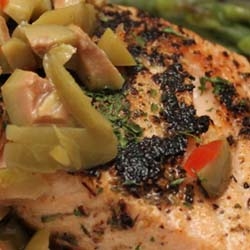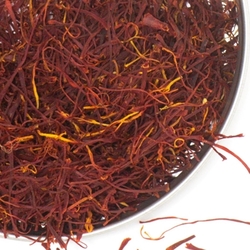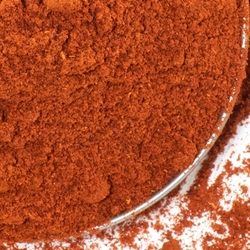
Over the years, the talk and popularity of the "Mediterranean diet" has continued to ebb and flow. Sometimes the media gives it lots of attention and then they predictably get bored and lose interest in it and it subsides a bit. The basics of this eating style are so well known that almost anyone that pays even a tiny bit of attention to it can spout off the Mediterranean Diet for Dummies spiel – the Mediterranean diet has you consuming lots of fresh fruits and vegetables, olive oil, fish, yogurt, cheese, eggs, wine, nuts, seeds, legumes and even some whole grains. Most people think that the Mediterranean lifestyle is limited to the area of Greece, but that would not be entirely accurate.
We love to experiment with a wide variety of cuisines, and while authentic Mexican (not the Tex-Mex version), Latin American and North African dishes tend to be my preferred choices (can you tell that I love spicy) we're always trying to learn and understand as much as possible on healthier eating in various worldwide cuisines.
The Mediterranean region encompasses countries that surround the Mediterranean Sea and actually covers three continents – Europe, Asia and Africa and 25 countries in all. One of the European countries in this region is Spain, and like many other countries (especially one that is about the size of Alaska at almost 195,000 square miles), there are foods, spices and recipes that vary from region to region. Spain, with its long and storied history, has three distinct regions and while today foods and recipes aren't quite as localized as they've been in the past, there are still some subtle nuances.
This region is also frequently referred to as "Mediterranean Spain" and it's known for its hot summers and mild winters with the sudden occasional bursts of rain. Andalusia, the Balearic Islands, Catalonia, Murcia and Valencia all have a rich culinary history that ties in closely with other countries in the region, most notably southern France, Italy and Morocco.
Catalonia has a well deserved reputation in the creation and spread of a unique food culture. The people of the northeastern Spanish province of Catalonia are known to be very creative with a strong independent spirit?Catalonia is a unique autonomous community within Spain (almost like a separate country). The province has its own language, Catalan, and a distinctive sense of style in architecture, fashion and industrial design.
Catalonian cuisine has its roots in Old World ingredients that were popular along the Mediterranean coast. This includes fresh vegetables such as garlic, tomatoes, eggplant, paprika chiles, mushrooms and artichokes. Also popular are bread, various types of cheese, legumes, olive oil, pasta and wine. Popular meats include pork (especially sausage and ham), chicken, lamb and fish such as cod and tuna. The diverse traditional Catalan cuisine ranges from fish focused recipes along the coast to pork dominant dishes inland. Several popular dishes combine sweet and savory stews with pork sausage and the characteristic sauce picada, which is made from ground almonds, hazlenuts and pine nuts and sometimes includes biscuits, garlic and herbs.
From the Catalonia region come 5 culinary sauces that are used as bases in creating flavorful dishes throughout Spain. The best known of these sauces is romesco. This earthy, smoky pepper and nut sauce is commonly used on fish. Vegetables play a starring role in Catalonia cuisine and are frequently served as a main course instead of as side dishes like we do in this country. Saffron and Sweet Smoked Paprika are commonly used spices that provide both layers of flavor and complexity to dishes instead of relying predominantly on fish or meats for flavor. Olive oil is the cooking medium used in many dishes and adds its own subtle nuanced flavor. In Spain, olive oil is frequently used for grilling, marinating and sauteing, and dishes often are finished with a final drizzle.
One of the most popular dishes in Spain is Paella, and communal paella cooking and even paella competitions are common in village festivals, especially in the Valencia region. While today most associate seafood as the meat of choice in Paella dishes, this meal was originally a laborers' meal. It was cooked over an open fire in the fields and eaten using wooden spoons directly from the pan. Since this meal was prepared in the fields of Valencia, the choices of meat tended to be chicken, duck rabbit and snails.
Located in southern Spain, but still bordering the Mediterranean Sea, Andalucia is one of the country's largest provinces and the food from this region is considered to be some of the healthiest in the world. The foundation of Andalucian cooking traces its roots back over 800 years of Moorish rule which left a culinary imprint of refined, oriental-like flavors, with includes a rich use of almonds, fruit, herbs and spices in savory dishes. Andalucia is also the world's largest producer of olive oil. Many sophisticated foodies believe that Andaucia's major contribution to the culinary landscape is cold soups of which the best known is probably gazpacho, which is actually a traditional peasant food made from olive oil, bread and crushed garlic.
Northern Spain
The Northern region of Spain faces the Atlantic and Cantabrian Sea and is a damp green region of vast pastures and lush wooded mountains. Apples, chestnuts, pears and walnuts grow abundantly here. The mountainous forests are filled with game including birds, deer, rabbits and wild boar. The rivers are known for their salmon and trout while the coastline has numerous fishing villages that bring in a huge variety of seafood including what many believe are some of the best crustaceans in Europe.
The Basque region curves around the Bay of Biscay and these waters provide an abundance of fish and seafood that play a prominent role in Basque cuisine. Traditional Basque cooking uses few spices, and instead relies on fresh ingredients, garlic, olive oil and salt for flavoring. The masters of Basque cuisine almost intuitively know how to cook precisely to a food's 'optimal point', where not even one more second is needed. In this region you're also more likely to find rabbit as the meat of choice instead of chicken.
Central Spain
This high, dry plateau covers a vast amount of land with some of the best known regions being La Mancha, Madrid and Extremadura. While this is a large region, there is not much culinary diversity.
Extremadura got its name from the region's extremely hard winter conditions. This area produces some of the best cheese and pork products in all of Spain. La Mancha produces what may be Spain's most recognized cheeses Manchego, which is often served thinly sliced over a bed of Serrano ham. This region has a reputation as being the world's largest supplier of saffron as more than 70% of the world's production comes from here.
Staple dishes range from simple broths such as warm garlic soup to complex winter dishes such as cocido madrilène (chickpeas and meat stew). This area of Spain may be best known for its roasted meats such as goat, lamb, suckling pig or veal. These meats are roasted slowly in wood ovens and the result is an exceptionally flavorful taste and texture.
More than Just Greece
So if you're looking to dig a bit deeper into healthy and flavorful Mediterranean cuisines don't neglect Spain as she has plenty to offer. Heck, you might even be able to impress a few of your foodie friends armed with this new knowledge, and certainly your taste buds will thank you.
Related Posts
Living the Mediterranean Diet
Middle Eastern Spices, Seasonings and Food
California: One of the World's Healthiest Cuisines
The World's Healthiest Cuisines - Italy



